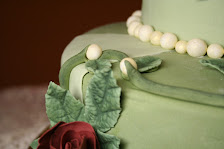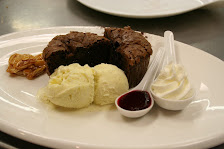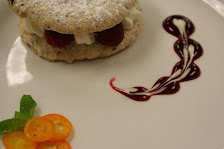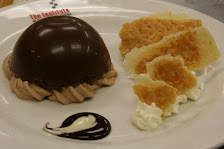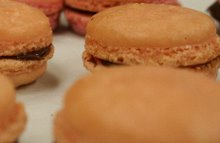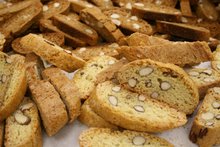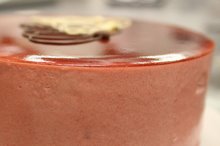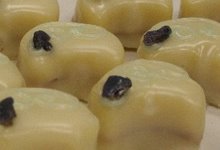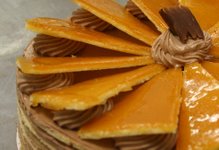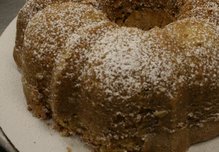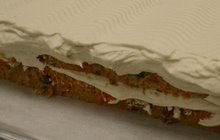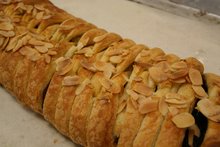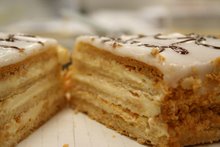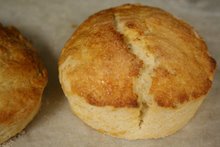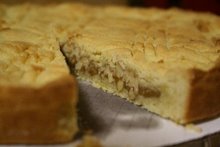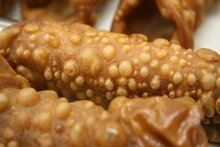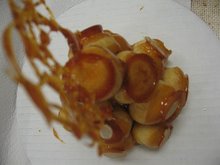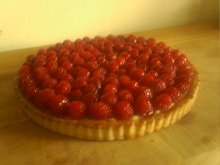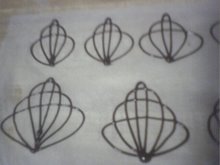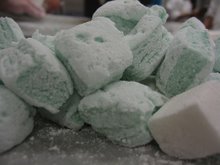Days 51, 52, and 53: Pounds. Carrots. Rums.
Cake has begun, much to the danger of all around me. The threat was apparent from the very beginning, when we started with that commonest of all cakes, the pound cake.
There are varying schools of thought with pound cake. In the first method, the flour and sugar are creamed together very thoroughly with the butter. (Don’t even think about gluten; there’s way too much fat sitting between each little starch granule for them ever to become acquainted.) The liquids are then added and away it bakes. I tend to think of this as the Southern Method, since any pound cake I’ve had from the South has been of the texture this produces, which is light, fluffy, crumbly, and perfectly balanced with a clear flavor. The other method, which simply to equalize the matter I consider the Northern Method, is what you might think of as more traditional, if you’re from up this way. The butter and sugar are creamed together, eggs are beaten in, and then milk is added in alternating steps with the remaining dry ingredients. This results in a cake of a denser, less crumbly texture, and a richer buttery flavor (but not the oily quality of the plastic-wrapped slices at every deli in New York). Both cakes having completely disappeared with equal speed leaves me to conclude that neither the North nor the South will win this particular war. Both are good, in their own ways, and I can’t personally choose which I prefer. Unless, that is, we’re talking about the next pound cake, which I must have made with one or the other of the methods… forgive me if I can’t remember. I was probably distracted by the rum and hazelnuts we were adding.
We also created another cake that’s ubiquitous and overridingly popular: carrot cake with cream cheese frosting. A terrifyingly easy cake to make, we filled and then frosted ours with delectable cream cheese buttercream. I’m certain that the icing recipe made nearly double what we needed, to accommodate the huge amount of it we’d eat during the process. (I was reminded of the butter-tasting incident from Day 2, only whilst high on sugar.) We learned the messy way to frost a cake. It wasn’t a primary concern that things weren’t perfect, since we were to freeze the cakes overnight and trim them the next day. This is when a pall was cast over my carrot cake, after having promised a piece of it to no fewer than seven people. I had mistakenly put it in the fridge instead of the freezer. On the day we were to be trimming, mine was too soft to cut properly, so into the freezer it went to be cut up during the next lesson. When I arrived at that lesson, with the mob of people who did not get their carrot cake barely at bay behind me, I was confounded to find that it had disappeared from the freezer, nowhere to be found. (My theory, after noticing that a large amount of ice crystals had accumulated in the freezer, was that my cake too became covered in them, and someone threw it away. I’m not a very suspicious person, I guess.) I suppose I learned an important lesson, even if it had nothing to do with baking or frosting: don’t promise people carrot cake, just surprise them with it.
We finished the week with our first lesson in How to Frost Prettily. I don’t know if it’s an industry secret or not, but here goes. Put your cake layer on a round of cardboard that’s about the size of the cake. Spread big globs of frosting over it, and top it with the next layer. You then want to ensure that the cardboard at the bottom is about one-quarter inch larger than the cake all the way around. If it isn’t, trim the cake with a bread knife, without worrying about trimming it perfectly roundly. Then, with a metal spatula, put great heaps of frosting on the sides, using the cardboard as a guide by scraping against it. Allow the frosting to mount up past the top edge, and do this all the way around. Then, spread more piles of frosting on the top, going past the side edges. Don’t freak out about it, just do your best to make it smooth and level. Then, again using the cardboard as a guide, scrape the extra frosting off the sides, smoothing as you go. It’s pretty foolproof if you have a little patience and keep your spatula clean. If you expect it to look flawless or don’t have at least a little patience, just go buy a cake. We iced our white cake with a lightly rum-flavored buttercream, which I cannot recommend wholeheartedly enough.
Making all these cakes one after another made me come to wonder why in the world anyone with more than 6 minutes would bother using a boxed mix. It’s tremendously easy to do it properly from scratch, the only aspect approaching difficulty being the finishing, which you’d have to do in any case. The flavor of a homemade cake is pure butter and vanilla (and, as the case may be, chocolate or carrot or spice), and the sublime texture will make you question why you would ever even admit the boxed stuff was food. It seems like the lesson of this short first week of cake might simply have been to show us all how simple it really is.
Even easier than pie.
Saturday, March 31, 2007
Thursday, March 29, 2007
Day 50: Test. Paper. Halfway.
Mostly logistical at this point, so let’s keep this brief.
We had the usual written exam, which I aced.
We had the usual practical exam, consisting of creating soft rolls to the point of readiness for the oven, but without baking (although one other student and I stayed late to bake ours, since they looked particularly good), and then making puff pastry by hand. Both went very well and I received full credit.
I also did pretty well on the paper (which, for those of you who just can’t get enough verboseness, can be found here). My topic being Middle Eastern baking, a look at the region’s breads was highly informative in terms of human history and political geography, as well as of the breads themselves.
The report card we received the next week showed me at a .07 reduction in my overall GPA due to the day that I was out sick – the fact that I made the project for that day at home, perfectly, using my own equipment and ingredients, apparently notwithstanding. I might push my luck on this one; I’ll keep you posted. If I felt it were fair I wouldn’t mind so much.
Halfway done!
Mostly logistical at this point, so let’s keep this brief.
We had the usual written exam, which I aced.
We had the usual practical exam, consisting of creating soft rolls to the point of readiness for the oven, but without baking (although one other student and I stayed late to bake ours, since they looked particularly good), and then making puff pastry by hand. Both went very well and I received full credit.
I also did pretty well on the paper (which, for those of you who just can’t get enough verboseness, can be found here). My topic being Middle Eastern baking, a look at the region’s breads was highly informative in terms of human history and political geography, as well as of the breads themselves.
The report card we received the next week showed me at a .07 reduction in my overall GPA due to the day that I was out sick – the fact that I made the project for that day at home, perfectly, using my own equipment and ingredients, apparently notwithstanding. I might push my luck on this one; I’ll keep you posted. If I felt it were fair I wouldn’t mind so much.
Halfway done!
Sunday, March 25, 2007
Days 47, 48, and 49: Coating. Tunneling. Snapping.
We continued in this last week of our second quarter with the process of lamination. Any dough which is rolled thin, spread with fat, folded, and rolled thin again (this process being repeated any number of times) is called a “laminated” dough. A very common one was the puff pastry we had made the week before; a very uncommon one (that I know only through my research on Middle Eastern breads for our second final project) is malooga, a Yemeni flatbread which is prepared in the same way. The one most recognized around the world though, is probably the croissant, which we finally got to this week. Surely right on the croissant’s heels is the Danish, which we also made.
The origin of the croissant goes (something) like this: in Vienna (yes, which is not in France), bakers were working in the very early morning, when they heard alarming noises coming from what seemed to be underneath the city. They alerted the authorities, and lo and behold, the Ottomans were tunneling their way under the city to sack it. The military responded and before you knew it, the invaders were squashed in one fell stroke. The bakers were credited with saving the city, and, in recognition of their heroism, they were graciously permitted to create a new pastry. (Rodney Dangerfield should have been telling this story.) They thus created the croissant, its crescent shape a sort of middle finger to the Ottoman Empire (who symbolized itself with the crescent, as the Turkish flag still does). But I digress.
The major difference between puff pastry and both croissant and Danish doughs is that the latter two contain yeast. Obviously this creates rise, but that fact is fairly significant when you compare it with puff pastry. There, the only way to obtain a perfect rise is through a thorough and perfect rolling and folding technique, allowing the moisture in the butter to push the many layers of dough up and apart with stunning ease and surprising efficacy. With these new two doughs, however, the fact that the yeast aids the rise allows us to create it with fewer turns of dough, and, at the same time, promotes a degree of evenness in the rise of the final product.
We began with Danish. This smooth and cooperative dough (ok, sorry to interrupt, but I have a rather large digression on which to embark: My core philosophy with food is, and long has been, that it should be comprised of natural, whole, real ingredients – ingredients which we can identify. As my food education continues, both leisurely and formally, I have begun to learn that certain things like xanthan-, carageenan-, and guar gums are natural plant derivatives, so my derision of them has concluded. However, thanks to food shortages and industrialization efforts during and after WWII, there are other widespread and odious ingredients in food today, and they’re dually demonic. The only thing they contribute to food, by and large, is stability; not flavor, not texture, not quality, simply shelf-life. Meanwhile, as is coming to light even now, hydrogenated fats are… well, they’re just not good for you. Same goes for high-fructose corn syrups, polysorbates, mono- and di-glycerides, modified food starch… what are all these things? Not to sound prideful but I’ve read a fair amount about food science and I know where they come from and how they’re made, but I still don’t quite know what they are. When something is derived from “pineapple,” I get it. I can imagine it. When something is derived from “polyoxylated sorbitol and oleic acid,” you really start to lose me; I’ve never seen that on any tree and I’ve been in a few forests now. If all this sounds like hippie, tree-hugging nonsense, examine this trend: heart disease, cancer, diabetes, and food allergies are at an all-time high for us as a species, and these conditions are especially prevalent in regions whose food supply is tainted with these things. Won’t you please join me in crusading, at least in your own daily eating and cooking, for pure, clean, true food? It’s not your fault or mine that these things have become staples in the American diet, but we can do something about it. That being said, I should mention that Danish dough) is one of the few products that benefits from the use of margarine. It gives the dough an even softer texture, and the butter flavor of the margarine doesn’t come across as chemical or overpowering in the final product. We did, however, use butter in ours, kneading an amount of flour into it, and the final product was truly excellent. We formed ours into a number of fruit envelopes (the shape most closely resembling what most of us think of as “Danish”), and into one long prune-filled braid.
Proceeding, we made croissants. (Here’s an oddity for you: all my snobbery and French lessons aside, I hope you find it enlivening that I say cruh-‘sahnts, not ‘cghrwa-soh. It’s okay, we live in America.) For as many times as I’ve failed in making these at home, it went fairly well. We didn’t have enough time to allow them to rise properly, so they didn’t expand to the light and airy state that anyone enjoying a croissant would generally prefer. However, for some reason not too many of us complained about a product that was a little heavier and in which the butter was more concentrated. In general, not a huge event. Next time, though, watch out.
We followed these slightly off but clearly understood pastries with a different sort of croissant. Pains au chocolat, or “chocolate croissants” as they’re callously called here, share the top of my Great Pyramid of Favorites with crème brûlée and donuts. Since I left France, I’ve been trying to find a good one; this above all other food matters so far has been my grail quest. The defining factor of a good one, for my money, is a certain amount of “snap” to the chocolate; it shouldn’t be soft. This way, rather than eating a goo-filled croissant, you’re eating a real croissant at the same time as real chocolate, and what could possibly be better than that? Finding a proper one of these is a true quandary. Certainly don’t get one from a coffee-shop chain; their chocolate is downright mushy. Corporations aren’t the only ones who missed the boat; it’s hard to find a good one even from a great bakery. When we made them in class, I was a little ho-hum, my longtime discouragement about this nitpicky little detail a foregone conclusion at this point. We were each given a number of small, narrow bars of compound chocolate (that is, chocolate which has had a small amount of vegetable oil mixed in, so it doesn’t break down in the heat of the oven – it’s all-natural, mind you!). We enrobed these bars in small rectangles of croissant dough, sealing them on the bottom. Shortly after pulling them from the oven, the fact that they were really too hot to eat was trumped by the incredible aroma filling the room, and we all set upon them like a pack of hyenas at the end of a thin year. The chocolate, of course, was gooey, but the pain au chocolat was heavenly anyway. The next morning, I packed two of these delightful creations for breakfast. When I bit into the first I was slightly more exuberant at my desk than I may have been in quite some time… for the first time in nine years, my teeth stopped at the chocolate and I had to bite just a tiny bit harder to break through it before it surrendered itself to my startled, happy mouth. Not a minor difference. When that snap is there, the chocolate melts at the same moment that the flavor of the butter comes to full light, and both of them float away together on a raft of gossamer pastry.
Sailing into the ecstatic glory of a perfect sunset.
We continued in this last week of our second quarter with the process of lamination. Any dough which is rolled thin, spread with fat, folded, and rolled thin again (this process being repeated any number of times) is called a “laminated” dough. A very common one was the puff pastry we had made the week before; a very uncommon one (that I know only through my research on Middle Eastern breads for our second final project) is malooga, a Yemeni flatbread which is prepared in the same way. The one most recognized around the world though, is probably the croissant, which we finally got to this week. Surely right on the croissant’s heels is the Danish, which we also made.
The origin of the croissant goes (something) like this: in Vienna (yes, which is not in France), bakers were working in the very early morning, when they heard alarming noises coming from what seemed to be underneath the city. They alerted the authorities, and lo and behold, the Ottomans were tunneling their way under the city to sack it. The military responded and before you knew it, the invaders were squashed in one fell stroke. The bakers were credited with saving the city, and, in recognition of their heroism, they were graciously permitted to create a new pastry. (Rodney Dangerfield should have been telling this story.) They thus created the croissant, its crescent shape a sort of middle finger to the Ottoman Empire (who symbolized itself with the crescent, as the Turkish flag still does). But I digress.
The major difference between puff pastry and both croissant and Danish doughs is that the latter two contain yeast. Obviously this creates rise, but that fact is fairly significant when you compare it with puff pastry. There, the only way to obtain a perfect rise is through a thorough and perfect rolling and folding technique, allowing the moisture in the butter to push the many layers of dough up and apart with stunning ease and surprising efficacy. With these new two doughs, however, the fact that the yeast aids the rise allows us to create it with fewer turns of dough, and, at the same time, promotes a degree of evenness in the rise of the final product.
We began with Danish. This smooth and cooperative dough (ok, sorry to interrupt, but I have a rather large digression on which to embark: My core philosophy with food is, and long has been, that it should be comprised of natural, whole, real ingredients – ingredients which we can identify. As my food education continues, both leisurely and formally, I have begun to learn that certain things like xanthan-, carageenan-, and guar gums are natural plant derivatives, so my derision of them has concluded. However, thanks to food shortages and industrialization efforts during and after WWII, there are other widespread and odious ingredients in food today, and they’re dually demonic. The only thing they contribute to food, by and large, is stability; not flavor, not texture, not quality, simply shelf-life. Meanwhile, as is coming to light even now, hydrogenated fats are… well, they’re just not good for you. Same goes for high-fructose corn syrups, polysorbates, mono- and di-glycerides, modified food starch… what are all these things? Not to sound prideful but I’ve read a fair amount about food science and I know where they come from and how they’re made, but I still don’t quite know what they are. When something is derived from “pineapple,” I get it. I can imagine it. When something is derived from “polyoxylated sorbitol and oleic acid,” you really start to lose me; I’ve never seen that on any tree and I’ve been in a few forests now. If all this sounds like hippie, tree-hugging nonsense, examine this trend: heart disease, cancer, diabetes, and food allergies are at an all-time high for us as a species, and these conditions are especially prevalent in regions whose food supply is tainted with these things. Won’t you please join me in crusading, at least in your own daily eating and cooking, for pure, clean, true food? It’s not your fault or mine that these things have become staples in the American diet, but we can do something about it. That being said, I should mention that Danish dough) is one of the few products that benefits from the use of margarine. It gives the dough an even softer texture, and the butter flavor of the margarine doesn’t come across as chemical or overpowering in the final product. We did, however, use butter in ours, kneading an amount of flour into it, and the final product was truly excellent. We formed ours into a number of fruit envelopes (the shape most closely resembling what most of us think of as “Danish”), and into one long prune-filled braid.
Proceeding, we made croissants. (Here’s an oddity for you: all my snobbery and French lessons aside, I hope you find it enlivening that I say cruh-‘sahnts, not ‘cghrwa-soh. It’s okay, we live in America.) For as many times as I’ve failed in making these at home, it went fairly well. We didn’t have enough time to allow them to rise properly, so they didn’t expand to the light and airy state that anyone enjoying a croissant would generally prefer. However, for some reason not too many of us complained about a product that was a little heavier and in which the butter was more concentrated. In general, not a huge event. Next time, though, watch out.
We followed these slightly off but clearly understood pastries with a different sort of croissant. Pains au chocolat, or “chocolate croissants” as they’re callously called here, share the top of my Great Pyramid of Favorites with crème brûlée and donuts. Since I left France, I’ve been trying to find a good one; this above all other food matters so far has been my grail quest. The defining factor of a good one, for my money, is a certain amount of “snap” to the chocolate; it shouldn’t be soft. This way, rather than eating a goo-filled croissant, you’re eating a real croissant at the same time as real chocolate, and what could possibly be better than that? Finding a proper one of these is a true quandary. Certainly don’t get one from a coffee-shop chain; their chocolate is downright mushy. Corporations aren’t the only ones who missed the boat; it’s hard to find a good one even from a great bakery. When we made them in class, I was a little ho-hum, my longtime discouragement about this nitpicky little detail a foregone conclusion at this point. We were each given a number of small, narrow bars of compound chocolate (that is, chocolate which has had a small amount of vegetable oil mixed in, so it doesn’t break down in the heat of the oven – it’s all-natural, mind you!). We enrobed these bars in small rectangles of croissant dough, sealing them on the bottom. Shortly after pulling them from the oven, the fact that they were really too hot to eat was trumped by the incredible aroma filling the room, and we all set upon them like a pack of hyenas at the end of a thin year. The chocolate, of course, was gooey, but the pain au chocolat was heavenly anyway. The next morning, I packed two of these delightful creations for breakfast. When I bit into the first I was slightly more exuberant at my desk than I may have been in quite some time… for the first time in nine years, my teeth stopped at the chocolate and I had to bite just a tiny bit harder to break through it before it surrendered itself to my startled, happy mouth. Not a minor difference. When that snap is there, the chocolate melts at the same moment that the flavor of the butter comes to full light, and both of them float away together on a raft of gossamer pastry.
Sailing into the ecstatic glory of a perfect sunset.
Tuesday, March 13, 2007
Days 43, (44,) 45, and 46: You thought strudel was thin.
It seems I forgot to mention what was probably the most enjoyable aspect of making strudel, so allow me to regress for a moment. The thing which allows the dough to be stretched to such inconceivable dimensions is of course gluten. The fun part is getting that gluten to the appropriate emotional state to accommodate extension to such dramatic proportions. Where kneading is enough for bread dough, which needs the gluten to be strong enough to trap air but not much stronger, strudel's gluten obviously needs to be much more thoroughly developed and forgiving. The way you do this is to mix the dough, and then to bang the dickens out of it. You accomplish this is to grab the dough and then throw it - hard enough to use the word "slam" - against the table. Our recipe specified that this was to be done one hundred times; this number seemed a little arbitrary to me, but it was neither insufficient nor excessive, and it worked well. What this does is shock the gluten into formation by slamming the individual microscopic strands of it into one another so they adhere (basically), as opposed to kneading, which invites them together for a nice afternoon tea. As you might imagine, the room became a bit noisy for a short while, but the free therapy this activity provided lasted days.
During the week following strudel, our gaze narrowed to even thinner dough as we dedicated ourselves to four days with puff pastry, that Ionian column of the confectionery. The first type we prepared was "quick" puff pastry, which is made in very much the same way as flaky pie dough or pâte brisée. After this mealy dough is just brought together, with lumps of butter averaging the size of peas, it is rolled into a rectangle, which is given what is called a "double turn" - the short ends are folded into the center, and then the whole dough is folded along that center line. After adequate rest (no gluten here, thanks) and chilling, this process is repeated three times, resting again between every other fold or so. Quick puff pastry is only quicker than the classic version (hold on, we'll get there) when it comes to mixing... the same rules of rolling, folding, and resting apply to all forms of this dough. This dough doesn't puff up to quite the glory of its much more fussed-over cousin, but it still gives the baker adequate push for things like cinnamon-almond straws (which were unstoppable, truly) and little savory things, like the parmesan-paprika palmiers my team fashioned as well. We were also introduced to the mille-feuille, which translates directly as "thousand leaves." To make this very popular confection, the goal is to bake the sheets of dough, which tend to puff up quite vigorously, while at the same time trying to keep the dough as flat as possible. It basically involves a number of sheet pans stacked on top of one another and a lot of squashing things down in hot ovens. This seems silly I'm sure, but the result is a deeply rich and crispy layer of pastry, which flakes apart when broken. I can't visualize another way of making a preparation like this (and I would imagine that if there were, they might have shown it to us since it would most certainly have been simpler).
The next day was my first and hopefully last absence from class, due to strep throat. Our task for that particular Tuesday was the creation of classic puff pastry dough by hand. Not wanting to fall behind, I made it at home – I don't know how I happened to have on hand the two-and-a-half pounds of butter that this recipe requires, but not many people were too surprised when I mentioned that part, so I guess I shouldn't be either. I found the actual preparation of it rather enjoyable. When I returned to class the following day, my homemade dough in hand, everyone seemed moderately annoyed at having had to make puff pastry; and I didn't understand what the hubbub was. But then, when Chef looked at mine and said "huh," I began to think, Gee, maybe I'm not annoyed by doing it because I was doing it wrong. Any error I might have made in preparation, though, was obscured in the final baking process; everything came out pretty spiff. We used it to create more straws and palmiers (sweet this time), which puffed quite a bit more dramatically than those made from the quick dough, and also the classic pithiviers, which consists of two layers of puff pastry enclosing a mound of frangipane, a nut dough (almost always almond) whose fragrance and divine flavor permeate not only the pastry itself but the entire kitchen. Before baking, the top of the pithiviers is scored in a decorative pattern, and a look at the lines will give any potential employer a very accurate picture of just how advantageously neurotic their potential pastry cook will be. We also created an apple strip, which is a long rectangle of puff pastry bordered by slightly higher walls, lined with frangipane and sliced apples. As you can imagine, the variations here in terms of filling and topping are pretty much endless, and my mind wanders back to that gorgeous pastry cream-cognac-apricot concoction of a few weeks ago. (I'll let you know how that one goes.)
If I may say so, I felt I had reached a new level in my education with the final item I produced with this marvelous dough. I created a mille-feuille having used classic puff pastry, which necessitated quite a bit more pushing down during baking but resulted in a pastry layer that was impeccably even in color, flavor, and texture. These layers I alternated with lightened pastry cream, and then, having iced it with a white glaze and covered the sides in crumbled puff pastry (as is traditional), I actually opted to do some cornet work on top. (I know, I know!) The result, though, is a testimony to why we bothered learning cornet work to begin with. This may have been my favorite thing so far. Trumping all three hundred twelve earlier favorites.
So, the preparation. To make classic puff pastry does require a certain amount of patience, which is why most restaurants buy theirs in frozen sheets of only-slightly-lower quality than homemade. You begin by forming a soft dough, using cold water. This step goes fairly quickly, and while the dough rests somewhere, you proceed by kneading cold butter (which you soften by beating it into submission with a rolling pin) with a small amount of flour until the butter is completely smooth in texture. Ideally, the texture of the butter mixture will match the texture of the dough itself. The butter is formed into a block, the dough spread into a large square. The block of butter is then placed on the dough, which is wrapped around it and sealed tightly at all seams. This package of three layers, dough-butter-dough, is then rolled into a rectangle and given a double turn. This is repeated, with resting and chilling of course, three more times, resulting in a final product of (I think) 768 alternating layers of dough and butter (right?). When placed into an adequately hot oven, the moisture in the butter evaporates and very forcefully puffs the layers of dough apart. This works more evenly and impressively than quick puff pastry because between all those layers of dough, the butter is spread out in one giant, even sheet, not in several thousand large squashed pieces. The rise is quite tremendous, a mere eighth-inch piece of puff pastry rising to an inch or more, each impossibly thin layer visible from the side. When chewed, the resistance these layers provide to the teeth, as they are first pressed together and then shorn through, give puff pastry a unique and positively heavenly texture.
Let’s just say I had plenty of communion, then.
It seems I forgot to mention what was probably the most enjoyable aspect of making strudel, so allow me to regress for a moment. The thing which allows the dough to be stretched to such inconceivable dimensions is of course gluten. The fun part is getting that gluten to the appropriate emotional state to accommodate extension to such dramatic proportions. Where kneading is enough for bread dough, which needs the gluten to be strong enough to trap air but not much stronger, strudel's gluten obviously needs to be much more thoroughly developed and forgiving. The way you do this is to mix the dough, and then to bang the dickens out of it. You accomplish this is to grab the dough and then throw it - hard enough to use the word "slam" - against the table. Our recipe specified that this was to be done one hundred times; this number seemed a little arbitrary to me, but it was neither insufficient nor excessive, and it worked well. What this does is shock the gluten into formation by slamming the individual microscopic strands of it into one another so they adhere (basically), as opposed to kneading, which invites them together for a nice afternoon tea. As you might imagine, the room became a bit noisy for a short while, but the free therapy this activity provided lasted days.
During the week following strudel, our gaze narrowed to even thinner dough as we dedicated ourselves to four days with puff pastry, that Ionian column of the confectionery. The first type we prepared was "quick" puff pastry, which is made in very much the same way as flaky pie dough or pâte brisée. After this mealy dough is just brought together, with lumps of butter averaging the size of peas, it is rolled into a rectangle, which is given what is called a "double turn" - the short ends are folded into the center, and then the whole dough is folded along that center line. After adequate rest (no gluten here, thanks) and chilling, this process is repeated three times, resting again between every other fold or so. Quick puff pastry is only quicker than the classic version (hold on, we'll get there) when it comes to mixing... the same rules of rolling, folding, and resting apply to all forms of this dough. This dough doesn't puff up to quite the glory of its much more fussed-over cousin, but it still gives the baker adequate push for things like cinnamon-almond straws (which were unstoppable, truly) and little savory things, like the parmesan-paprika palmiers my team fashioned as well. We were also introduced to the mille-feuille, which translates directly as "thousand leaves." To make this very popular confection, the goal is to bake the sheets of dough, which tend to puff up quite vigorously, while at the same time trying to keep the dough as flat as possible. It basically involves a number of sheet pans stacked on top of one another and a lot of squashing things down in hot ovens. This seems silly I'm sure, but the result is a deeply rich and crispy layer of pastry, which flakes apart when broken. I can't visualize another way of making a preparation like this (and I would imagine that if there were, they might have shown it to us since it would most certainly have been simpler).
The next day was my first and hopefully last absence from class, due to strep throat. Our task for that particular Tuesday was the creation of classic puff pastry dough by hand. Not wanting to fall behind, I made it at home – I don't know how I happened to have on hand the two-and-a-half pounds of butter that this recipe requires, but not many people were too surprised when I mentioned that part, so I guess I shouldn't be either. I found the actual preparation of it rather enjoyable. When I returned to class the following day, my homemade dough in hand, everyone seemed moderately annoyed at having had to make puff pastry; and I didn't understand what the hubbub was. But then, when Chef looked at mine and said "huh," I began to think, Gee, maybe I'm not annoyed by doing it because I was doing it wrong. Any error I might have made in preparation, though, was obscured in the final baking process; everything came out pretty spiff. We used it to create more straws and palmiers (sweet this time), which puffed quite a bit more dramatically than those made from the quick dough, and also the classic pithiviers, which consists of two layers of puff pastry enclosing a mound of frangipane, a nut dough (almost always almond) whose fragrance and divine flavor permeate not only the pastry itself but the entire kitchen. Before baking, the top of the pithiviers is scored in a decorative pattern, and a look at the lines will give any potential employer a very accurate picture of just how advantageously neurotic their potential pastry cook will be. We also created an apple strip, which is a long rectangle of puff pastry bordered by slightly higher walls, lined with frangipane and sliced apples. As you can imagine, the variations here in terms of filling and topping are pretty much endless, and my mind wanders back to that gorgeous pastry cream-cognac-apricot concoction of a few weeks ago. (I'll let you know how that one goes.)
If I may say so, I felt I had reached a new level in my education with the final item I produced with this marvelous dough. I created a mille-feuille having used classic puff pastry, which necessitated quite a bit more pushing down during baking but resulted in a pastry layer that was impeccably even in color, flavor, and texture. These layers I alternated with lightened pastry cream, and then, having iced it with a white glaze and covered the sides in crumbled puff pastry (as is traditional), I actually opted to do some cornet work on top. (I know, I know!) The result, though, is a testimony to why we bothered learning cornet work to begin with. This may have been my favorite thing so far. Trumping all three hundred twelve earlier favorites.
So, the preparation. To make classic puff pastry does require a certain amount of patience, which is why most restaurants buy theirs in frozen sheets of only-slightly-lower quality than homemade. You begin by forming a soft dough, using cold water. This step goes fairly quickly, and while the dough rests somewhere, you proceed by kneading cold butter (which you soften by beating it into submission with a rolling pin) with a small amount of flour until the butter is completely smooth in texture. Ideally, the texture of the butter mixture will match the texture of the dough itself. The butter is formed into a block, the dough spread into a large square. The block of butter is then placed on the dough, which is wrapped around it and sealed tightly at all seams. This package of three layers, dough-butter-dough, is then rolled into a rectangle and given a double turn. This is repeated, with resting and chilling of course, three more times, resulting in a final product of (I think) 768 alternating layers of dough and butter (right?). When placed into an adequately hot oven, the moisture in the butter evaporates and very forcefully puffs the layers of dough apart. This works more evenly and impressively than quick puff pastry because between all those layers of dough, the butter is spread out in one giant, even sheet, not in several thousand large squashed pieces. The rise is quite tremendous, a mere eighth-inch piece of puff pastry rising to an inch or more, each impossibly thin layer visible from the side. When chewed, the resistance these layers provide to the teeth, as they are first pressed together and then shorn through, give puff pastry a unique and positively heavenly texture.
Let’s just say I had plenty of communion, then.
Thursday, March 1, 2007
Days 40, 41, and 42: Getting thinner.
The dough, of course; not me. Actually, before busting out the rolling pins, we began the week with some biscuits. It seems like a non sequitur from last week’s crust lessons, and after those colorful fifty-dollars-each tarts, a little like the shack among mansions. Biscuit dough, however, is made in much the same way as a pâte brisée; the fat is thoroughly rubbed into the dry ingredients until the mixture is mealy and uniform, and then the liquid is added. We used the classic White Lily flour, whose biscuits have graced the Southern table for as long as chitterlings (yes, that’s really how that’s spelled, can you believe it!?) and gravy. We also formed some scones by the same method. My team was lucky to have received the lemon-cornmeal scone recipe as an assignment. Several other teams were to prepare chocolate scones, and just as in the Great Donut Fiasco some weeks ago, they didn’t come out too hot. (Maybe they make the recipes that sound the best come out the worst in order to keep that fabled freshman twenty-seven at a level that wouldn’t beg too many lawsuits.) In any case, the biscuits were light and many-layered and flaky, and the scones had a delightful crispness from the cornmeal along with a refreshing hint of lemon.
Readying our pins and using a bit of dough we had made the week before, each team made a number of tiny tartlets. The whole process with this type of pastry, from weighing the ingredients to weighing yourself the morning after you’ve eaten too many of them, is the perfect training ground for the patience a pastry chef must learn. Each of these little desserts takes a fair bit of time to make: you form the dough, then chill, roll, mold, bake, and cool it; you make the pastry cream (or citrus curd, buttercream, or other filling), and cool it; you prepare miniscule slivers of whatever it is you’re planning to put on top. Then, finally, you’re up to filling and topping, the latter of which is best done with a pair of tweezers. After that, they’re ready for presentation and eating. And you watch the microcosmic fruit of so much labor disappear in one bite, or maybe one and a half if the eater is particularly demure. This teaches you to break the emotional bond with your products very quickly. (The value of which, as anyone who related to my sourdough disaster on Day 32 could tell you, cannot be overestimated.) That said, they were very elegant, and envisioning row upon row of them conjures images of the best-catered party any of us have been to.
We used a bit more of the same dough, rolled thin again, to make a Breton. This pastry, named for the Bretagne region of France, is basically a thinly veiled excuse to enclose candy in pastry and call it a dessert. We made a walnut caramel, placed it in a pastry shell, and then topped it with a second layer. Then, as if to further disguise its nature, we gave it a rustic fork design across the top. (No one in the country eats candy, everyone knows that.) Not that I’m complaining, mind you. It was awfully good.
From there we proceeded to the thinnest dough so far, the fabled Hungarian strudel. This dough is truly a marvel to behold. It begins as somewhat ordinary dough. You take a pound or so of it, and on a table covered with a clean cloth and amply floured, you begin to stretch it. You stretch and stretch, always using the backs of your hands, until the dough is thin enough to read through. (When I had read about strudel, I always thought it was just an expression to “read newsprint through” it, but seeing the clearly defined edges of my burn scar as the back of my hand stretched the dough toward me taught me otherwise.) What you’re left with at the end is a giant sheet (and I mean giant – ours was about six feet by eight feet), stretched so thin that you can see the gluten not only for the transparent membrane that it is, but also for its incredible extensibility if rested properly. After all the oohs and aahs had died down, we brushed the whole sheet with butter, strew breadcrumbs across it, and added our filling. I had chosen apple for our team, being somewhat the classicist but also wishing to avoid things like those mid-winter plums I’m always going on about. Then, the three of us lifting the tablecloth gingerly, gently, and in perfect concert, we began to roll up this monster of a confection. When we had finally rolled the entire thing, we divided it into three pieces, each of which could still be called large. The final product was everything you could hope for in a strudel – thin, flaky layers of crisp pastry enrobing a lightly sweet and mildly spiced fruit filling, the whole of which simply melted into oblivion on the palate. Even given its superlative eating qualities, it’s understandable why making strudel this traditional way is somewhat a dying art. Not only is it labor-intensive, but it requires the undivided attention of at least two, and preferably three people to pull it off properly. There are tales of some people who can make this alone, which I’m sure there are.
Just nobody I know.
The dough, of course; not me. Actually, before busting out the rolling pins, we began the week with some biscuits. It seems like a non sequitur from last week’s crust lessons, and after those colorful fifty-dollars-each tarts, a little like the shack among mansions. Biscuit dough, however, is made in much the same way as a pâte brisée; the fat is thoroughly rubbed into the dry ingredients until the mixture is mealy and uniform, and then the liquid is added. We used the classic White Lily flour, whose biscuits have graced the Southern table for as long as chitterlings (yes, that’s really how that’s spelled, can you believe it!?) and gravy. We also formed some scones by the same method. My team was lucky to have received the lemon-cornmeal scone recipe as an assignment. Several other teams were to prepare chocolate scones, and just as in the Great Donut Fiasco some weeks ago, they didn’t come out too hot. (Maybe they make the recipes that sound the best come out the worst in order to keep that fabled freshman twenty-seven at a level that wouldn’t beg too many lawsuits.) In any case, the biscuits were light and many-layered and flaky, and the scones had a delightful crispness from the cornmeal along with a refreshing hint of lemon.
Readying our pins and using a bit of dough we had made the week before, each team made a number of tiny tartlets. The whole process with this type of pastry, from weighing the ingredients to weighing yourself the morning after you’ve eaten too many of them, is the perfect training ground for the patience a pastry chef must learn. Each of these little desserts takes a fair bit of time to make: you form the dough, then chill, roll, mold, bake, and cool it; you make the pastry cream (or citrus curd, buttercream, or other filling), and cool it; you prepare miniscule slivers of whatever it is you’re planning to put on top. Then, finally, you’re up to filling and topping, the latter of which is best done with a pair of tweezers. After that, they’re ready for presentation and eating. And you watch the microcosmic fruit of so much labor disappear in one bite, or maybe one and a half if the eater is particularly demure. This teaches you to break the emotional bond with your products very quickly. (The value of which, as anyone who related to my sourdough disaster on Day 32 could tell you, cannot be overestimated.) That said, they were very elegant, and envisioning row upon row of them conjures images of the best-catered party any of us have been to.
We used a bit more of the same dough, rolled thin again, to make a Breton. This pastry, named for the Bretagne region of France, is basically a thinly veiled excuse to enclose candy in pastry and call it a dessert. We made a walnut caramel, placed it in a pastry shell, and then topped it with a second layer. Then, as if to further disguise its nature, we gave it a rustic fork design across the top. (No one in the country eats candy, everyone knows that.) Not that I’m complaining, mind you. It was awfully good.
From there we proceeded to the thinnest dough so far, the fabled Hungarian strudel. This dough is truly a marvel to behold. It begins as somewhat ordinary dough. You take a pound or so of it, and on a table covered with a clean cloth and amply floured, you begin to stretch it. You stretch and stretch, always using the backs of your hands, until the dough is thin enough to read through. (When I had read about strudel, I always thought it was just an expression to “read newsprint through” it, but seeing the clearly defined edges of my burn scar as the back of my hand stretched the dough toward me taught me otherwise.) What you’re left with at the end is a giant sheet (and I mean giant – ours was about six feet by eight feet), stretched so thin that you can see the gluten not only for the transparent membrane that it is, but also for its incredible extensibility if rested properly. After all the oohs and aahs had died down, we brushed the whole sheet with butter, strew breadcrumbs across it, and added our filling. I had chosen apple for our team, being somewhat the classicist but also wishing to avoid things like those mid-winter plums I’m always going on about. Then, the three of us lifting the tablecloth gingerly, gently, and in perfect concert, we began to roll up this monster of a confection. When we had finally rolled the entire thing, we divided it into three pieces, each of which could still be called large. The final product was everything you could hope for in a strudel – thin, flaky layers of crisp pastry enrobing a lightly sweet and mildly spiced fruit filling, the whole of which simply melted into oblivion on the palate. Even given its superlative eating qualities, it’s understandable why making strudel this traditional way is somewhat a dying art. Not only is it labor-intensive, but it requires the undivided attention of at least two, and preferably three people to pull it off properly. There are tales of some people who can make this alone, which I’m sure there are.
Just nobody I know.
Subscribe to:
Posts (Atom)



